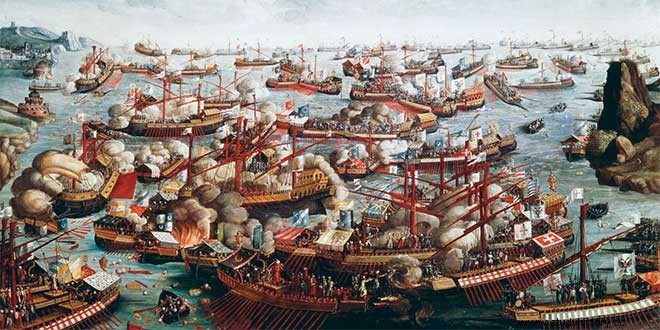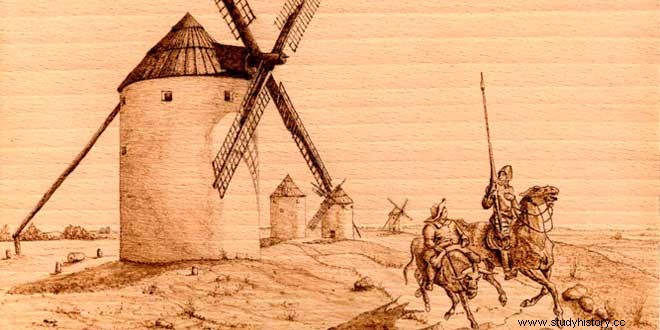Miguel de Cervantes Saavedra was born in Alcalá de Henares on September 29, 1547. He was the fourth son of the licensed surgeon Don Rodrigo de Cervantes and Doña Leonor de Cortinas . His father was deaf and poor, he pushed his family through various Spanish cities, including Valladolid, Madrid and Seville. It is known that in 1568 Miguel de Cervantes attended the school of Humanities of master Juan López de Hoyos in Madrid.
In 1569 Juan López de Hoyos published a Funeral History and Relationship in honor of the recently deceased Isabel de Valois, and included several poems by Miguel de Cervantes, preceded by a sincere and enthusiastic praise. But, for the time being, Miguel de Cervantes was in the service of Cardinal Aquaviva, at this time he went to Italy to enlist in Rome as a soldier under the command of Diego de Urbina, who, in turn, was a member of Marco Antonio Colonna. He participated in the battle of Lepanto, aboard the Marquesa galley , who defended the left wing of the squad. An arquebus left his left hand useless, for this reason he was known as the Manco de Lepanto and later recovered in a hospital in Messina.
A year later, he joined Don Lope de Figueroa's third. He attended the conquest of Tunis and gained enough prestige to go on to serve the Duke of Sessa; he applied for command of a company. He gathered letters of recommendation and went to present them in court.

Captivity stage
He embarked on the galley Sol and in front of Marseilles they ran into the pirate Arnaute Mami, who was an Albanian renegade. He boarded the ship Sol; and Miguel de Cervantes and his brother Rodrigo, who accompanied him on the trip, became the slaves of two Algerian potentates. Although Miguel's master, Ali-Mami, El Cojo . Between escape attempts and rescue attempts, more than four years passed. Cervantes sent a letter to the king's secretary, Mateo Vázquez, in which, after lamenting the misfortune of the captives, he indicated in detail the neatest way to conquer and disrupt that place. Perhaps because this document of high espionage was discovered or because of another similar fact, Miguel de Cervantes was sentenced to receive two thousand sticks in the ribs.
Miguel de Cervantes free
Finally, in 1580, Fray Juan Gil obtained the ransom, with which Cervantes found himself back in Spain, reduced to the sad condition, barely a degree higher than that of captive. But nothing — or very little — managed to be a student tutor. While he wrote on occasions, which were included in other people's books, he finished off the first part of La Galatea , obtaining the publication license in 1584. In this same year, Cervantes, who had already had a natural daughter with Ana Francisca de Rojas and whose daughter remained in his care, married Catalina de Palacios in Esquivias, a medium-sized landowner and deeply rooted in her land that did not follow her husband in his successive wanderings. Also in this year the surgeon Don Rodrigo de Cervantes passed away, with a will, but no inheritance. Finally, in 1587, Miguel de Cervantes obtains benefits from the will. Commissions for the purchase and sale of oil and barley were entrusted to him and due to his mismanagement of this type of task, he was involved in other people's bankruptcies and problems. These wanderings took him throughout Andalusia, while he was writing comedies and hors d'oeuvres. To fatten up his short salary, he did a concert with a Sevillian named Rodrigo Osorio , he had to give him part of those works, it is not known whether to represent and exploit them or to make them his own. But it seems that the agreement did not come to a good end, mainly due to the commercial and judicial problem that mortified the writer.
For not leaving Andalusia, he requested and obtained a position as supplier of the Invincible Armada , whose supplies were taken care of in Seville by Don Antonio Guevara. He gained a reputation as an honest and decent man, though not overly suited to the task. And despite the letters of recommendation that he obtained, it was not possible for him to obtain a destination in America. He did not obtain a place for America and, instead, a new trial and arrest, due to an accountability that was demanded of him, without being able to respond with coverage of funds or solvent guarantor, but later he was released.
With this, he abandoned the Invincible Armada to his fate and returned to Madrid for the time being, to put some order in his family affairs. He put his daughter Isabel as a companion or servant to his sister Magdalena, received the news of the death of his brother Rodrigo, in Flanders, and visited his wife in Esquivias.
Stage as writer
On September 20, 1604, Miguel de Cervantes obtained, in Valladolid, the privilege to print the book of chivalry called El Ingenioso Hidalgo Don Quixote de la Mancha , which came out in a rough edition. In spite of which, people received the book with laughter and it is already known that His Graceful Majesty, seeing a silly young man doubled over with laughter in a street, had to sentence:«In truth, that young man, or he has lost his brain , or has read Don Quixote».
His daughter Isabel had been widowed years ago by Don Diego Sanz de Aguila and was wanted by Luis Molina. Isabella's dowry was obtained by Miguel de Cervantes. Luis Molina managed some land in Cuenca, a cattle ironwork establishment entrusted to him by Don Juan de Urbina, secretary of the princes of Savoy, who had intervened as matchmaker for the couple. The blacksmith shop did not go well and debts were piled up by the dowry and the house where Cervantes lived was indebted, on Calle de la Montera.

Cervantes stayed in Madrid permanently, apart from occasional trips to Esquivias, and devoted himself fully to literature. He took part in gatherings, such as in the famous Jungle Academy , which met on Atocha Street, at Don Francisco Silva's house. He entered the pious Brotherhood of the Blessed Sacrament and the Venerable Third Order to his wife and his sister Andrea to him.
In 1613 his Novels appeared, on the cover of which he drew a self-portrait, for whose publication he obtained one thousand six hundred reales from the publisher Robles, less an urgent advance payment.
In 1615 he recounted the Persiles and Segismunda. He confesses in this book to suffer from incurable dropsy, and indeed, at the beginning of 1616, he writes to the Cardinal Primate, Archbishop Sandoval, a letter in which he communicates the suffering of an illness that has no cure. And that, in fact, it won't take a month to find his body in the grave.
Being already on his deathbed, Miguel de Cervantes entered the Third Venerable Order of San Francisco . His last literary work was to dedicate The Works of Persiles and Segismunda to the Count of Lemos, remembering only the benefits received. He did it four days before his death, according to Cejador and Frauca. And on April 22, 1616 he died , while his body was carried on the shoulders of the tertiaries from the house on Calle del León and buried in the Trinitarias de Ja calle de Cantarranas the next day, April 23, 1616 .
2016 marked the fourth centenary of the death of Miguel de Cervantes, there is a website with the timeline of his life.
